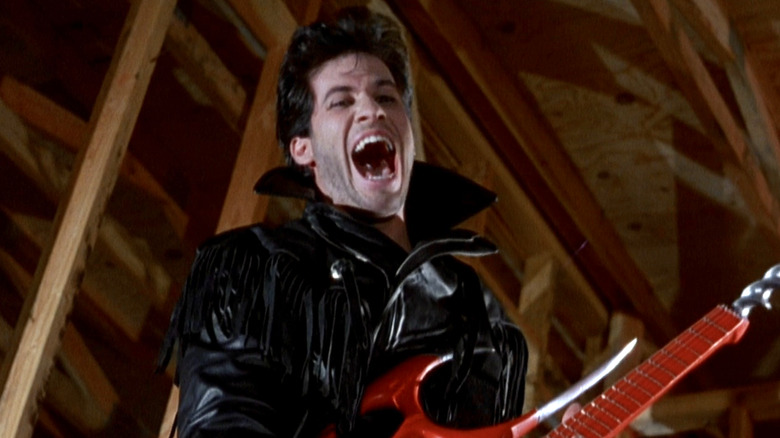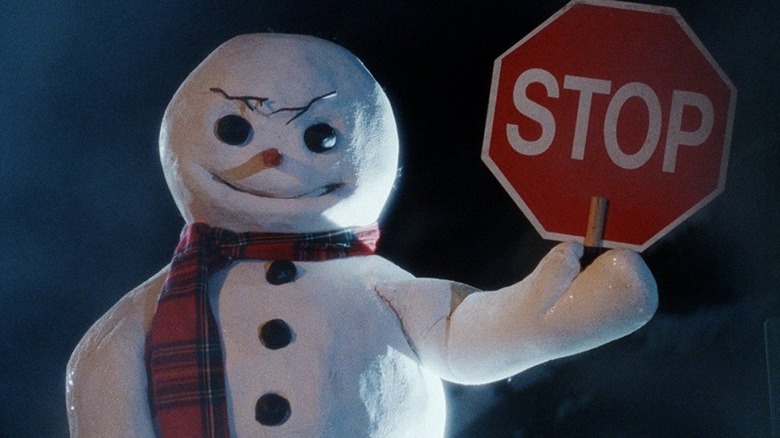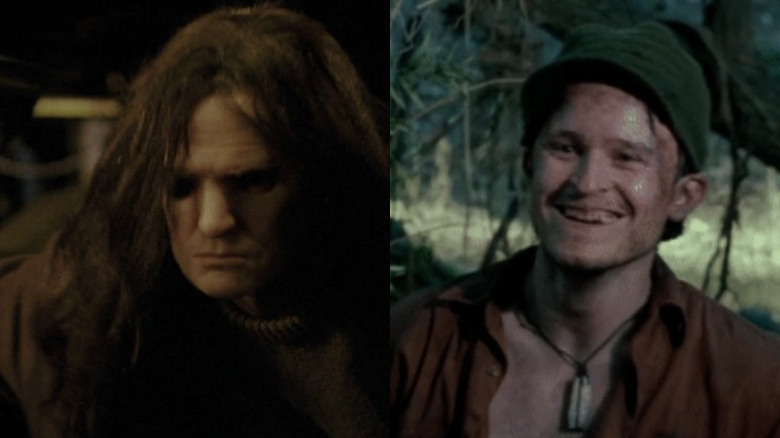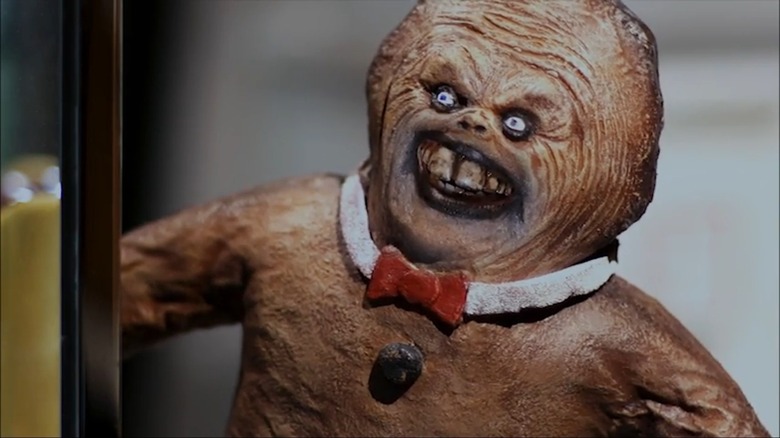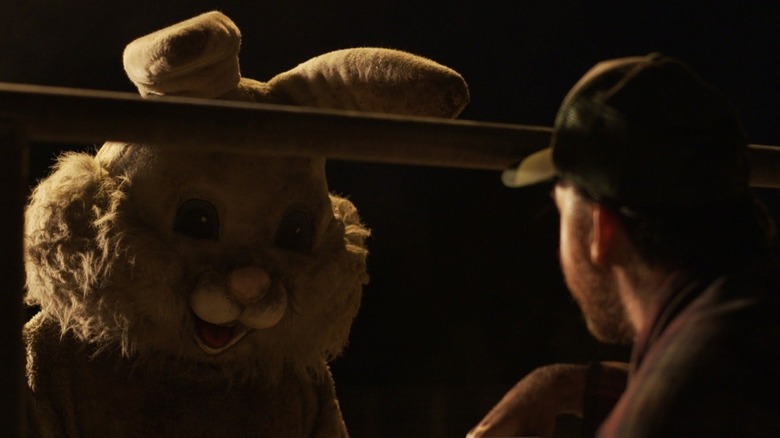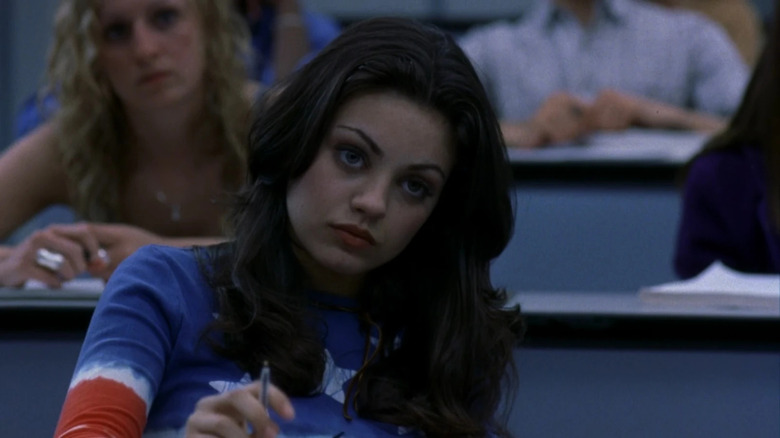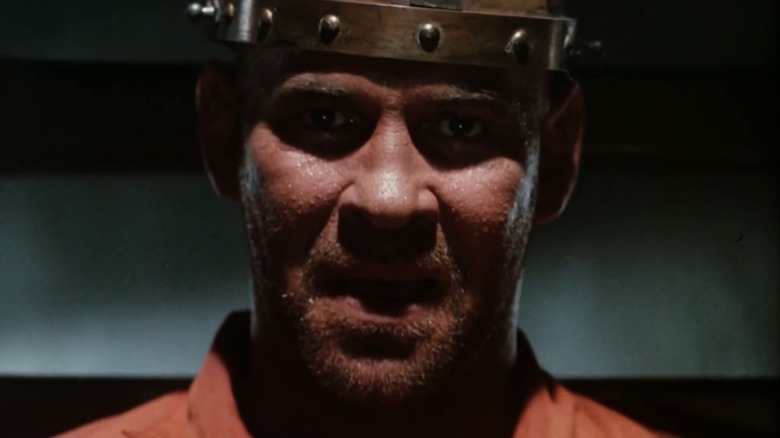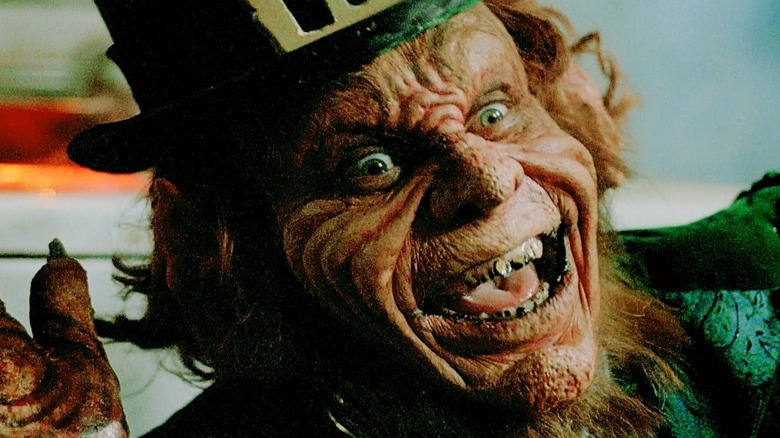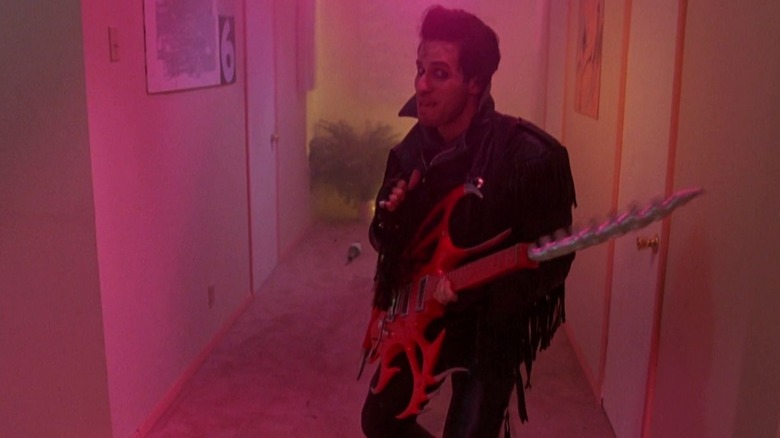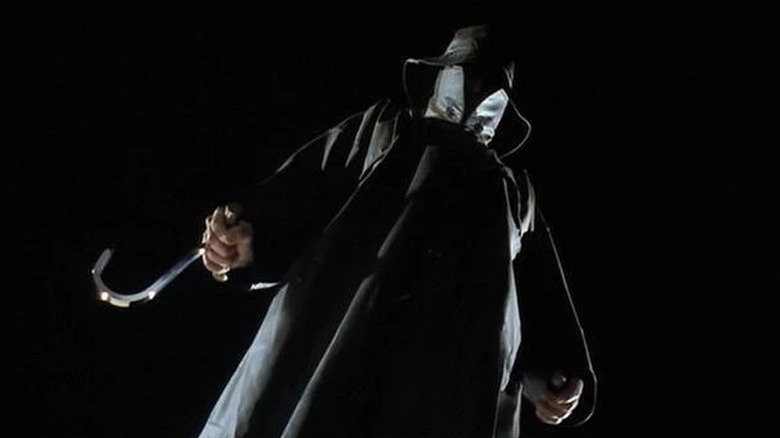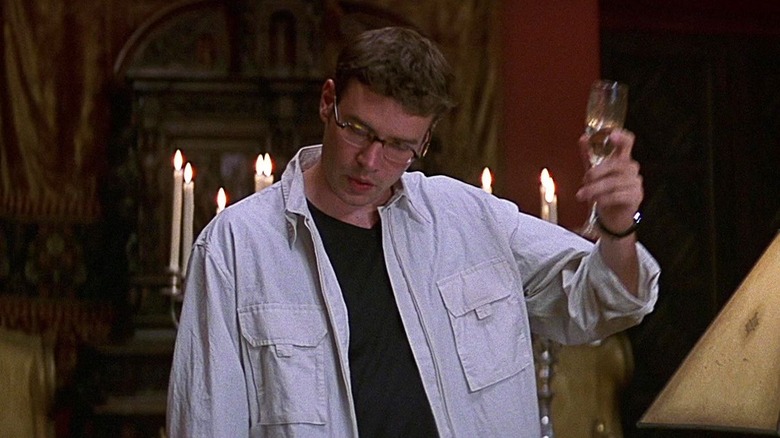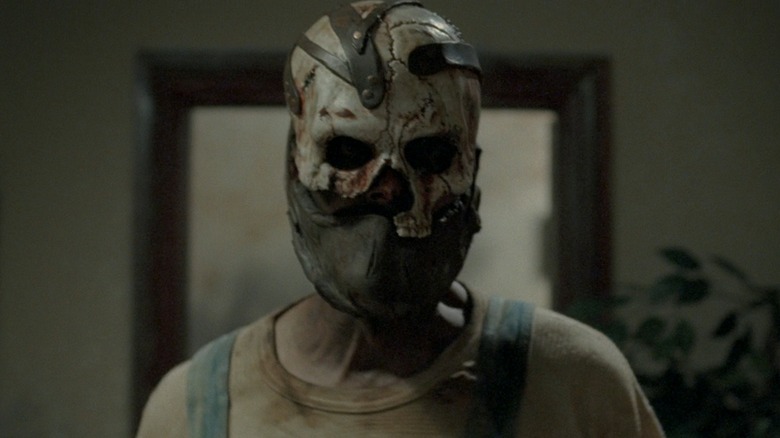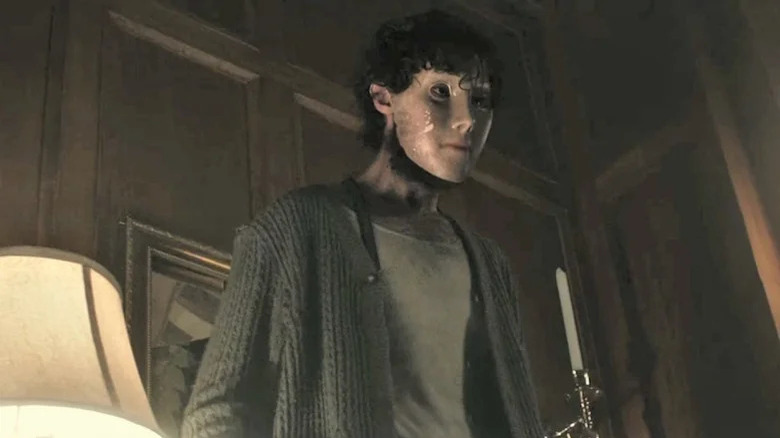The 12 Worst Slasher Villains Of All Time
The horror genre, like many others, is predicated on a vast sea of subgenres battling it out for eyeballs. For example, some films are entirely dedicated to zombies or vampires, while others focus entirely on family legacies, hauntings or found footage.
But perhaps horror's most reliable subgenre (at least, since the 70's breakthroughs of films like "Halloween" and "The Texas Chain Saw Massacre") has been slasher films, typically centered around a mad man with a large knife. Noteworthy slashers include the likes of Michael Myers, Chucky the Doll, Freddy Krueger and Leatherface, all demented killers who have gone on to become pop culture mainstays and annual Halloween costume favorites.
But not every slasher can reach the heights of Freddy or Jason; some are dead on arrival. Below, a breakdown of would-be movie killers who were either impressively ridiculous or thoroughly underwhelming, lacking in thematic intrigue and visual flair. They are the 12 worst slasher villains of all time.
Jack Frost, Jack Frost (1997)
Christmas horror movies are nothing new; the subgenre has been long populated by a slew of yuletide monsters and madmen. There are the killer Santa Clauses from six "Silent Night Deadly Night" films, the original "Black Christmas" and its remake, as well as "Krampus," which boasts not only a Christmas demon but also killer toys. But not every holiday haunt can be a winner, and some only exist as the white elephant gift nobody wants to receive.
"Jack Frost" — not the Michael Keaton family comedy, but the straight-to-video horror flick that preceded it by a year — tells the tale of a serial killer turned serial snowman named Jack Frost. When Frost (yes, that's the character's actual name) is accidentally exposed to genetically-altering chemicals while being transported to his execution, he gains freaky snowman powers that assist in his murdering proclivities.
By itself, a killer snowman isn't a bad idea; "Doctor Who" and the "Winter of '83" horror series have proven it can work. But where this particular monster falls apart is in its physical appearance, on par with an inflatable snowman on someone's front lawn. Needless to say, a cheap looking snowman with a comically mismatched voice and flapping Muppet mouth is not intimidating.
Today, the film is remembered (if at all) for a notorious scene where a naked woman, played by Shannon Elizabeth, is sexually assaulted in the shower by Jack. Boasting an abysmal 17% on Rotten Tomatoes, the film somehow spawned a 2000 sequel, "Jack Frost 2: Revenge of the Mutant Killer Snowman."
The Sinclair Brothers, House of Wax (2005)
In the '00s, the horror landscape was awash with remakes and re-imaginings of horror classics, many of which were despised by critics. Often, these glossier remakes missed the point of what had made the original so captivating. One such remake was "House of Wax," a notorious, headline-garnering dud starring Chad Michael Murray, Elisha Cuthbert and Paris Hilton.
The film only loosely pays tribute to the original, which starred Vincent Price and Charles Bronson (then billed as "Charles Buchinsky"), opting to go in a more contemporary direction, even embracing the "found footage" trend. Here, viewers meet a group of youths who, after some car trouble, find themselves in a small little town which contains a place called Trudy's House of Wax. After entering the decrepit tourist trap, the group find themselves menaced by Bo and Vincent, the Sinclair Brothers.
Once conjoined twins, now the duo are deranged murderers who opt to kill their victims by smothering them in hot wax. While their method of murder is disturbing, the brothers themselves are decidedly less so, with Bo looking fairly normal and Vincent wearing an unintentionally-comical mask. It ball relies heavily on backwoods psychopaths cliches dating back to stuff like "Chain Saw" and "Deliverance," but done here with significantly less grace. Lacking in both personality and visual flair, the Sinclair Brothers stand as a firm reminder of just how underwhelming horror of the '00s could be.
The Gingerdead Man, The Gingerdead Man (2005)
If you're looking for the height of foam rubber nonsense, look no further than Full Moon Entertainment's use of the work of Charles Band. Full Moon is perhaps best known for the "Puppet Master" movies, a franchise predicated on heavy uses of stop motion and foam rubber puppetry in the days when CGI wasn't yet a tool for such films.
But that's not all Full Moon is known for; such foam rubber practical props also yielded one of cinema's worst slasher villains ever. That would be "The Gingerdead Man," a film wherein a criminal's remains end up in a batch of cookies, thereby yielding a sentient killer cookie voiced by none other than Gary Busey.
That's right, a killer gingerbread man, and yes, it looks just about as ridiculous as you'd imagine in your head. Though undoubtedly ridiculous by design, the Gingerdead Man isn't the most likely character to instill nightmares in the minds of its viewers. Not unless someone's idea of terror is gluten, processed sugar and a four-inch-tall talking cookie man with a gap tooth and voiced by the star of "I'm With Busey."
Simply put, the film is a bakery of buffoonery, bogged down by a fittingly absurd slasher killer at the forefront, accentuated by cornball puppet effects. Clearly, the film wants to be so bad it's good, but with a killer who won't give anyone any actual scares, it's just so bad it's bad.
Bunnyman, Bunnyman (2011)
"Bunnyman" is frustrating, because the urban legend upon which it is loosely based could have been the basis for a very creepy movie. It tries to tell a story adjacent to the infamous Bunny Man Bridge, located in Fairfax Station, Virginia. The story goes that a young couple, en route from a football game, were spooked by a hatchet-wielding man described as wearing a white bunny suit. Later, a similar incident was reported, but due to a lack of any significant evidence, nothing ever materialized.
If this had been adapted in a similar fashion to films like "The Town That Dreaded Sundown," perhaps "Bunnyman" could have resulted in some gritty, haunting scares. Instead, the low-budget slasher film aspires to be an ode to trashy exploitation films of the '70s, but is absent any artistic merit. One need only look at the design of Bunnyman himself to understand why the film has an 18% for its audience score on Rotten Tomatoes. Bunnyman looks less like a haunting serial killer and more like a mascot for bootleg Cadbury Creme Eggs. It is a fittingly underwhelming slasher for an underwhelming film that lays an egg.
Rachael Newman, American Psycho II (2002)
Some might not realize there was an "American Psycho II"; chief among those would seem to be star Mila Kunis, who signed on to make a script called "The Girl Who Wouldn't Die" and subsequently found herself begging "Please — somebody stop this... When I did the second one, I didn't know it would be 'American Psycho II.' It was supposed to be a different project, and it was re-edited."
Nevertheless, Kunis found herself unwittingly attempting to follow in the footsteps on Christian Bale, whose Mary Herron-guided take on Bret Easton Ellis' 1991 novel was clever, thoughtful, and iconic — three things the straight-to-video "American Psycho II: All American Girl" was not.
The re-edited sequel cast Kunis as Rachael, a woman who once saw her babysitter tortured by Patrick Bateman, then killed him with an ice pick. This led her to develop an obsession with serial killers, causing her to pursue a career in criminology while also partaking in some murder-on-the-side herself.
Not only does the premise have little to do with the original film or the Ellis source material, but Kunis herself isn't exactly intimidating as a serial murderer. Whenever she's forced to be menacing, it plays like Jackie from "That 70s Show" cosplaying as a crazy person.
Horace Pinker, Shocker (1989)
In the '80s, as franchises like "Halloween" and "Friday the 13th" successfully cranked out sequels with regularity, there was an abundance of eccentric, bloody challengers to the throne flooding the market.
This was at a time when the home video market was in full swing; all your movie really needed was an eye-catching cover to pull in viewers. This resulted in various slasher films that weren't shooting for high quality, but more to rake in a decent profit with an alluring concept that could be easily conveyed in a cover box. A prime example of this is "Shocker," a lesser-known addition to the filmography of one of horror's finest, Wes Craven.
Craven, best known for creating "A Nightmare of Elm Street" and Freddy Krueger, was also responsible for creating Horace Pinker. Starring a young Peter Berg and marketed with a high-wattage metal soundtrack that included the likes of Megadeth, "Shocker" was no cheapie.
The film follows a serial-killing TV repairman who makes a deal with the devil to escape his execution. Repairman Pinker turns into pure electricity, permitting him to escape via a TV dish, into the airwaves. Now, Pinker can travel through televisions and other electronics, as well as invading people's dreams — add in a slightly-burned face, and it becomes pretty clear that Craven was trying to recapture his Freddy Krueger magic. But with Pinker's underwhelming design and some laughably antiquated visuals standing in for his powers, Horace Pinker did very little to stand out among his '80s peers.
Lubdan the Leprechaun, The Leprechaun films
Take a look at a picture of the Leprechaun, and you'll understand all that went wrong with this series. Perhaps the stupidest slasher to ever emerge from the 1990s, the Warwick Davis character may have scared Garth from "Wayne's World," but not many others.
1993's original "Leprechaun" which famously cast Davis as the titular villain opposite a pre-"Friends" Jennifer Aniston, focused on a group of people contending with a killer Leprechaun looking for his stolen gold. It could have been potentially creepy if not for one thing, a titular Leprechaun who is downright ridiculous to watch. It must be said that Davis, never one to phone in a performance, throws everything he has into the character, acting his heart out through the cheesy makeup. However, as energetic as his performance might be, there's no denying it is every bit as cornball.
Believe it or not, eight "Leprechaun" films have been produced, with a reboot recently announced. Davis hasn't played the gold-loving killer since 2003's "Leprechaun: Back 2 tha Hood," but Lubdan (no seriously, that's the Leprechaun's name) has been to Las Vegas and, much like Jason Voorhees, to outer space. He even, on two separate occasions, took a trip into the hood where he both smoked weed and rapped live on stage. Once your villain is touring the cosmos and smoking with pimps, his intimidation factor bottoms out quickly.
The Driller Killer, Slumber Party Massacre II (1987)
When it comes to the various films introduced during the slasher movie boom, few encapsulated the 1980s better than "The Slumber Party Massacre." From its soundtrack to the fashion and hairstyles of its characters, the film is a true time capsule in the best possible way. It also helps that the film's menace, Russ Thorn (AKA The Driller Killer) is intimidating if not particularly complex in his motivations.
The same can't be said for his revamped version in "Slumber Party Massacre 2," released five years after its predecessor. Following his demise in the first film, The Driller Killer has returned from beyond the grave via supernatural means. This time around however, the Driller Killer has fully embraced the decade, donning slicked back hair with a black leather jacket and his murder weapon, a red electric guitar. It might scare you — if you can look at this guy for more than 30 seconds without bursting into laughter.
Needless to say, a Mötley Crüe reject murdering people with a bright red musical instrument that has a drill on the end is far from a relatable daily concern for most. With a killer so outside the realm of reality, it shouldn't come as much of a shock that the sequel has a 43% audience score on Rotten Tomatoes.
Ben Willis, I Know What You Did Last Summer (1997)
In the late-90s, "Scream" helped inject new life into slasher films, after Jason, Freddy and the like began showing their age. Often forgotten, however, is the tag-team effort echoed by another hot Kevin Williamson script released in theaters between the first two "Scream" films: "I Know What You Did Last Summer."
Starring Jennifer Love Hewitt, Sarah Michelle Gellar, Ryan Phillippe and Freddie Prinze, Jr., the film is focused on a group of youths who, while driving down the coast for a beach party, hit a pedestrian by the name of Ben Willis. They make an impetuous decision to dispose of the body, and face no repercussions for the hit-and-run — until next year, when the group finds itself terrorized by a mysterious figure in a black raincoat, a black face covering and a black hat, coming at them wielding a rusty fishing hook.
His aesthetic is clearly inspired by the classic urban legend of the Hook, a campfire story usually concerning a hook-handed killer who escapes from a mental asylum. Despite "I Know What You Did Last Summer" being a fairly big hit at the box office, very few people ever mention Ben Willis (or "The Fisherman") as a memorable slasher on par with the likes of, say, Ghostface. While not a completely ineffectual murderer, this killer character just isn't interesting enough visually, or in terms of his backstory, to leave much of an impact.
Roman Bridger, Scream 3 (2000)
The "Scream" movies have seen their share of ups and downs; the original was overseen by Wes Craven, became a sensation that redefined its genre, and introduced viewers to both the Ghostface killer and the character of Sidney Prescott; from there, your mileage may vary.
Sidney, played by Neve Campbell, served as the series' final girl up until the events of "Scream 5," wherein she passed the torch. Throughout the series viewers have seen all manner of people come for Sidney under the Ghostface persona, including her boyfriend, her boyfriend's mother and even her own cousin. However, there is one antagonist that many "Scream" fans are less enthused to talk about: Roman Bridger, from the third film.
"Scream 3" is regarded by many as the weakest entry in the series, even boasting its lowest Rotten Tomatoes score. Introduced as the director of the latest "Stab" film (the film franchise within the series' universe), Roman is eventually revealed as the latest Ghostface. In a rather contrived twist, Roman explains that Sidney's deceased mother Maureen is also his mother. The reveal does not make a lick of sense within the franchise's continuity, and the series itself has mercifully gone out of its way ever since to ignore it.
Ted Radford, Midnight Movie (2008)
An obscure addition to the slasher sub-genre with an admittedly interesting setup, "Midnight Movie" follows Ted Radford, a man who directed and acted in a fictitious horror film titled "The Dark Beneath" decades ago, subsequently suffering a mental collapse.
As a method in his recovery, the hospital provides Radford with a copy of his film — which, through some quick blood magic, he's able to escape into. "Midnight Movie" then cuts ahead a few years, where a local movie theater plans to show "The Dark Beneath" as its midnight movie.
A group of attendees (including an employee and her little brother) must now contend with Radford, who has taken the form of his old film's killer. It's all somewhat outside-the-box and intriguing, but this is where the film falls apart, as Ted Radford is as generic as a slasher killer can get.
Radford's mask, a bizarre hybrid of a skull and a black cloth mask, seems like it'd be more at home on the walls of a Spirit Halloween store. Also, since he's mostly mute for the majority of the film, Radford has very little in the way of a personality to make him anything worth connecting with. "Midnight Movie" might be far from the bottom of the barrel, but it would have benefited greatly from a villain with just a bit more flair.
Brahms, The Boy (2016)
Another film with great potential that ultimately comes up short, the Rupert Evans movie "The Boy" is another example of the baddie letting us down.
The film introduces viewers to Greta Evans (Lauren Cohan), a babysitter hired by the Heelshires, an elderly couple living in the UK. Greta is tasked with attending to their son Brahms (James Russell), but the situation is far from the standard babysitting gig. Brahms is actually a life-sized porcelain doll in a suit, which the Heelshires treat as if he's alive. Despite the off-putting nature of this, Greta accepts and even agrees to the Heelshires' list of rules regarding him, including playing music as loud as possible for him.
Following the Heelshires' departure, strange things start to happen in the house, indicating that the Brahms doll might somehow be indeed alive. Ultimately, a twist is revealed that makes the explanation far less interesting than a possessed doll — and leaves Brahms out to twist in the wind, exposed in his lameness as the entire premise falls apart. Brahms is a perfect example of what happens when the film's killer simply can't live up to the hype — and fear — that is built up around it.
